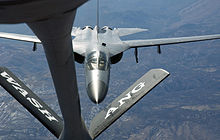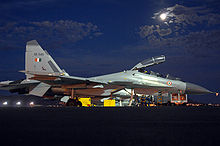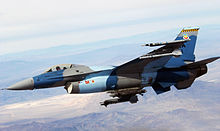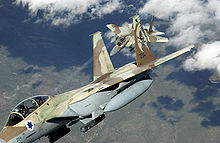- Red Flag (United States Air Force)
-
This article is about US Air Force exercises. For other uses, see Red flag (disambiguation).
Red Flag is an advanced aerial combat training exercise hosted at Nellis Air Force Base, Nevada and Eielson Air Force Base, Alaska, the latter location being known as Red Flag – Alaska and being a successor to the previous COPE THUNDER exercise series. Since 1975, air crews from the United States Air Force (USAF) and other U.S. military branches and allies take part in one of several Red Flag exercises held during the year, each of which is two weeks in duration.
The Red Flag exercises, conducted in four to six cycles a year by the 414th Combat Training Squadron of the 57th Wing, are very realistic aerial war games. The purpose is to train pilots from the U.S., NATO and other allied countries for real combat situations. This includes the use of "enemy" hardware and live ammunition for bombing exercises within the Nevada Test and Training Range.
Contents
Organization
The mission of the 414th Combat Training Squadron (Red Flag) is to maximize the combat readiness and survivability of participants by providing a realistic training environment and a forum that encourages a free exchange of ideas. To accomplish this, combat units from the United States and its allied countries engage in realistic combat training scenarios carefully conducted within the Nellis Range Complex. The Nellis Range complex is located northwest of Las Vegas and covers an area of 60 nautical miles (111 km) by 100 nautical miles (190 km), approximately half the area of Switzerland. This space allows the exercises to be on a very large scale.
 An Australian F-111 bomber approaching a Washington Air National Guard KC-135 tanker during Red Flag 06-1
An Australian F-111 bomber approaching a Washington Air National Guard KC-135 tanker during Red Flag 06-1
In a typical Red Flag exercise, Blue Forces (friendly) engage Red Forces (hostile) in realistic combat situations. Blue Forces are made up of units from the Air Combat Command, Air Mobility Command, United States Air Forces Europe, Pacific Air Forces, Air National Guard, Air Force Reserve Command, U.S. Army, U.S. Navy, U.S. Marine Corps, Royal Air Force, and Canadian Air Force, as well as other allied air forces. They are led by a Blue Forces commander, who coordinates the units in an "employment plan". Red Forces (adversary) are composed of the 57th Wing's 57th Adversary Tactics Group, flying F-16s (64th Aggressor Squadron) and F-15s (65th Aggressor Squadron) to provide realistic air threats through the emulation of opposition tactics. The Red Forces are also augmented by other U.S. Air Force, U.S. Navy and U.S. Marine Corps units flying in concert with the 507th Air Defense Aggressor Squadron's electronic ground defenses and communications, and radar jamming equipment. The 527th Space Aggressor Squadron (Active Duty) and 26th Space Aggressor Squadron (Air Force Reserve) also provide GPS jamming. Additionally, the Red Force command and control organization simulates a realistic enemy integrated air defense system (IADS).
A key element of Red Flag operations is the Red Flag Measurement and Debriefing System. RFMDS is a computer hardware and software network which provides real-time monitoring, post-mission reconstruction of maneuvers and tactics, participant pairings and integration of range targets and simulated threats. Blue Force commanders objectively assess mission effectiveness and validate lessons learned from data provided by the RFMDS. A typical flag exercise year includes ten Green Flags (a close air support exercise with the Army), one Canadian Maple Flag (operated by Canadian Forces Air Command) and four Red Flags. Each Red Flag exercise normally involves a variety of fighter interdiction, attack, air superiority, defense suppression, airlift, air refueling and reconnaissance missions. In a 12-month period, more than 500 aircraft fly more than 20,000 sorties, while training more than 5,000 aircrews and 14,000 support and maintenance personnel.
Before a "flag" begins, the Red Flag staff conducts a planning conference where unit representatives and planning staff members develop the size and scope of their participation. All aspects of the exercise, including billeting of personnel, transportation to Nellis, range coordination, munitions scheduling, and development of training scenarios, are designed to be as realistic as possible, fully exercising each participating unit's capabilities and objectives.
Origin
 Indian Air Force's Sukhoi Su-30MKI conduct post-flight maintenance during the Red Flag exercise in 2008.
Indian Air Force's Sukhoi Su-30MKI conduct post-flight maintenance during the Red Flag exercise in 2008.
The origin of Red Flag was the unacceptable performance of U.S. Air Force pilots in air combat maneuvering (ACM) (air-to-air combat) during the Vietnam War in comparison to previous wars. Air combat over North Vietnam between 1965 and 1973 led to an overall exchange ratio (ratio of enemy aircraft shot down to the number of own aircraft lost to enemy fighters) of 2.2:1 (for a period of time in June and July 1972 during Operation Linebacker the ratio was less than 1:1).
Among the several factors resulting in this disparity was a lack of realistic ACM training. USAF pilots were not versed in the core values and basics of ACM due to the belief that BVR (Beyond Visual Range) missile engagements and equipment made close-in maneuvering combats obsolete. As a result of this BVR-only mindset that reached its zenith in the early 1960s, nearly all USAF pilots and weapons system officers (WSO) of the period were unpracticed in maneuvering against dissimilar aircraft because of a concurrent Air Force emphasis on flying safety.
An Air Force analysis known as Project Red Baron II showed that a pilot's chances of survival in combat dramatically increased after he had completed 10 combat missions. As a result, Red Flag was created in 1975 to offer USAF pilots and weapon systems officers the opportunity to fly 10 realistically simulated combat missions in a safe training environment with measurable results. Many U.S. air crews had also fallen victim to SAMs during the Vietnam War and Red Flag exercises provided pilots and WSOs this experience in this regime as well.
The concept of Colonel Richard "Moody" Suter became the driving force in Red Flag's implementation, persuading the then-Tactical Air Command commander, General Robert J. Dixon, to adopt the program. At Nellis, Suter was well-known and well-liked. He had flown 232 Vietnam combat missions and brought to the table a level of professional expertise that was indisputable.[citation needed]
The series of briefings that Suter delivered inspired enthusiasm among key personnel at Nellis.[citation needed] The first Red Flag exercise came off on Gen Dixon's schedule in November 1975. On 1 March 1976, the 4440th Tactical Fighter Training Group (Red Flag) was chartered with Col P.J. White as the first commander, Lt Col Marty Mahrt as vice commander, and Lt Col David Burner as Director of Operations. This small crew under Col White's leadership undertook the task of firmly establishing the program. Their hard, imaginative work over the early years would confirm Red Flag's promise and turn it into the finest training system in aviation history.[citation needed]
The "aggressor squadrons", the opponents who flew against the pilots undergoing training, were selected from the top fighter pilots in the U.S. Air Force. These pilots were trained to fly according to the tactical doctrines of the Soviet Union and other enemies of the period, in order to better simulate what then-TAC, as well as USAFE, PACAF and other NATO pilots and WSOs would likely encounter in real combat against a Soviet, Warsaw Pact, or a Soviet-proxy adversary. The aggressors were originally equipped with readily available T-38 Talon aircraft to simulate MiG-21, the T-38 being similar in terms of size and performance. F-5 Tiger II fighters, painted in color schemes commonly found on Soviet aircraft, were added shortly thereafter and became the mainstay until the F-16 was introduced.
Today, the 414th Combat Training Squadron (414 CTS) is the unit currently tasked with running Red Flag exercises, while the 64th Aggressor Squadron (64 AGRS) and the 65th Aggressor Squadron (65 AGRS) also based at Nellis AFB use F-16 and F-15 aircraft to emulate, respectively, the MiG-29 Fulcrum and Su-30 Flanker. These aircraft continue to be painted in the various camouflage schemes of potential adversaries.
The U.S. Air Force's Red Flag approach differs from that initially employed during the Vietnam War by the United States Navy to improve fighter aircrew performance. Rather than a large, multi-squadron exercise, the Navy established the United States Navy Fighter Weapons School (more widely known as TOPGUN) in 1969 at the former NAS Miramar, California to "train the trainers," with Navy and Marine Corps squadrons in the Fleet, selecting their best air crews for training. Graduates returned to the Fleet to share lessons learned with their fellow pilots and naval flight officers. Navy and Marine Corps adversary squadrons were also later established at fighter and attack Master Jet Bases (NAS Miramar (now MCAS Miramar), NAS Oceana, NAS Lemoore, MCAS Yuma, NAS Key West and NAS Fallon, as well as the former NAS Cecil Field, for Fleet squadrons to conduct dissimilar air combat training as part of unit level training. These squadrons initially flew the A-4 Skyhawk. The Navy and Marine Corps later added the F-5E/F to its adversary lineup and briefly included the F-21 Kfir. Other naval adversary aircraft have include specially built F-16Ns, the F-14 and the F/A-18. Today, Carrier Air Wing level training, analogous to the USAF Red Flag program, is conducted at NAS Fallon, where the Naval Strike and Air Warfare Center (NSAWC), of which TOPGUN in now part, operates dissimilar adversary aircraft (F-16 and F/A-18), while a collocated squadron, VFC-13, flies the F-5E and F-5F.
The United States Marine Corps (USMC) conducts Weapons and Tactics Instructor (WTI) exercises at Marine Corps Air Station Yuma twice a year as part of the WTI course conducted by MAWTS-1 and uses locally-based VMFT-401, the only USMC adversary squadron. Originally equipped with the F-21 Kfir, it now operates the F-5E and F-5F.
Red Flag was also depicted in a 1981 TV movie "Red Flag: The Ultimate Game".[1] Red Flag is also featured in a 2004 IMAX film Fighter Pilot: Operation Red Flag.
Participating countries
Only countries considered close allies of the United States take part in Red Flag exercises. So far, the countries to have participated in these exercises are:
 United Kingdom
United Kingdom France
France Germany
Germany Japan
Japan Italy
Italy Canada
Canada Australia
Australia South Korea
South Korea Spain
Spain Pakistan (2010)
Pakistan (2010) Brazil (July 1998 and August 2008)
Brazil (July 1998 and August 2008) Netherlands
Netherlands Belgium
Belgium Sweden
Sweden
 Denmark
Denmark Norway
Norway Portugal (March 2000)
Portugal (March 2000) Greece (October 2008)
Greece (October 2008) New Zealand
New Zealand Singapore
Singapore Chile (July 1998)
Chile (July 1998) Israel
Israel Turkey
Turkey Saudi Arabia
Saudi Arabia United Arab Emirates
United Arab Emirates India
India Egypt
Egypt Venezuela (1992 and 1996)
Venezuela (1992 and 1996)
Incidents
Crashes are not unknown; in 1980 a fatal crash occurred when an RAF Blackburn Buccaneer suffered failure of the main spar.[citation needed]
See also
- Red Flag – Alaska – Exercise based out of Eielson Air Force Base, Alaska (formerly Cope Thunder)
- MAPLE FLAG
- TOPGUN
- Opposing force
Notes
References
External links
Categories:- United States Air Force exercises
- Military in Nevada
Wikimedia Foundation. 2010.


